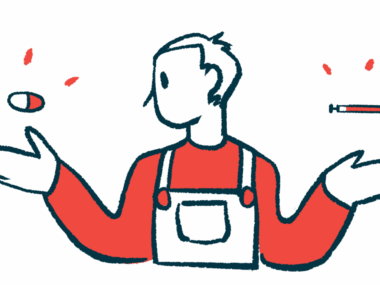Living with sarcoidosis can be scarier than any Halloween horror
The everyday fears I face while managing a chronic illness
Written by |

I was 7 years old when I saw “Poltergeist,” the 1982 film about a family that moves into a house possessed by angry spirits. While there are countless frightening moments in the film, the worst for me was when 8-year-old Robbie is attacked by his doll, a clown that smiles wickedly from a rocking chair as it waits for its moment to pounce.
As if the movie weren’t enough, my sister recreated the scene when we got home, leaving me in bed with my doll clown on her rocking chair, staring at me with its own sinister smile. Absolutely terrifying.
To this day, I cannot be around clowns. Forget the circus — I can’t watch a film or read a book that features them. I felt validated when I learned that it wasn’t just me. Coulrophobia, or fear of clowns, is a real and fairly common phenomenon. Yet the prevalence of evil clowns in pop culture proves that some people truly enjoy being scared.
This is the time of year that those people look forward to most. As we approach Halloween, haunted houses abound and horror films are shown around the clock. People shop for creepy costumes and find ways to spook one another, all in the name of fun. I can (somewhat) understand the appeal: Horror films offer a safety net for their audience. There is a scare, perhaps even a jump, but everyone knows there’s no real danger.
I’ll pass on all of that, especially now. Living with sarcoidosis, there is more than enough to be afraid of — and this fear is real.
The frights of chronic illness
It begins before the diagnosis, when we experience pain, fatigue, shortness of breath, and more. It can take several years and even more doctors to get an accurate diagnosis. With each of those visits and each of those tests, fear of the unknown leaves us wondering and worrying.
When we are diagnosed, there can be a moment of relief, but fear of the unknown remains, as most of us have never heard of sarcoidosis. A quick Google search might lead to something like the Bernie Mac Foundation, where we learn that the disease led to the death of this popular actor and comedian. At that point, it’s only natural to fear that we may have the same fate.
As we learn more about the disease, we discover that sarcoidosis can affect any part of the body, and there is no cure. Even if the disease isn’t fatal for us, it can bring years — even decades — of suffering. We learn that there aren’t many treatments, and those that do exist can cause severe side effects.
If we are able to find just the right combination to bring our symptoms under control, there can still be fear. We may be grateful for the progress, but afraid it may not last, because:
- Symptoms may return for any reason, or no reason at all.
- The disease may progress or develop in other organs.
- Insurance plans or formularies may change and no longer cover the necessary treatment.
- Our doctors may leave their practices, and new doctors may not understand our disease as well.
One great thing that comes with this disease is the supportive community that becomes an extended family. But with a family that is affected by sarcoidosis, it feels like every day I see someone who’s struggling, suffering, or has passed away as a result of this condition. That can cause fear on two levels: It’s awful to think of losing so many close friends, and losing them also makes us more aware of our own mortality.
Perhaps the greatest fear for many of us isn’t the disease itself, but how others will respond to it. Who should we tell, and how should we tell it? What will they think of us? If we need accommodations at work, colleagues don’t always understand; they may see us as lazy rather than legitimately sick. When we aren’t well enough to socialize, many whom we thought of as friends tend to fade away. Even when we have wonderful caregivers, we often feel like a burden, and a little voice in the back of our heads says they feel it, too.
The “Scream” series (the one exception to my avoidance of all things frightful) offers very specific rules for how to survive a horror movie. These films enable us to laugh at the fear, even through the fear. With sarcoidosis, there are no rules. It’s easy to get swallowed up by that fear, even paralyzed by it. But if we can find ways to laugh, and people to laugh with, living with sarcoidosis can be a little less scary.
“Laughter is poison to fear.” ― George R.R. Martin, “A Game of Thrones”
Note: Sarcoidosis News is strictly a news and information website about the disease. It does not provide medical advice, diagnosis, or treatment. This content is not intended to be a substitute for professional medical advice, diagnosis, or treatment. Always seek the advice of your physician or other qualified health provider with any questions you may have regarding a medical condition. Never disregard professional medical advice or delay in seeking it because of something you have read on this website. The opinions expressed in this column are not those of Sarcoidosis News or its parent company, Bionews, and are intended to spark discussion about issues pertaining to sarcoidosis.







Tiffinie
Thanks so much for this!
🦋 Kerry Wong
I'm glad you enjoyed, Tiffinie - thanks for reading!
~🦋
Joanna Kennedy
Thank you so very much I was diagnosed with sarcoidosis of the brain in 2022, it’s being a rough journey for me, reading your article gave me a peace of mind, thank you so very much,
🦋 Kerry Wong
Oh thank you, Joanna. It can definitely be a rough road, so I'm glad to bring you a bit of comfort. You are definitely not alone.
~🦋